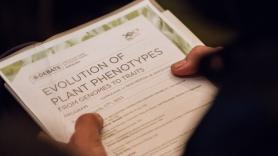3. Plant breeding: putting science into practice
Once we know of these modifications, can they be used to improve crops? In 2000, the first plant genome was published; today we have the full genome of more than 80 species, as well as the genome of different varieties of the same species: databases used continually by plant breeders.
For Josep Casacuberta, scientific leader of the event and former member of the European Food Safety Authority (EFSA) Panel on Genetically Modified Organisms, GMOs are neither the only nor the whole solution, but he advocates calming the alarm generated by this type of crop. “GMOs are subject to strict risk controls and, furthermore, new techniques allow much closer control of the changes introduced,” he says. One of these techniques is called CRISPR (Clustered Regularly Interspaced Short Palindromic Repeats), considered to be the great promise in gene therapy and whose use has even been proposed to modify human embryoes and prevent genetic diseases.
As Casacuberta points out, “genomic variations have been brought about in plants consistently throughout history: in the 1950s, X-rays were used to provoke modifications currently found in many foods. Without these advances,” he reiterates, “we wouldn’t be able to face the challenge of our future food needs and improving the species we eat.”
James Giovannoni, researcher at the Boyce Thompson Institute for Plant Research (New York), presented the research that has allowed his team to analyze mutations and the epigenetics and metabolomics (all of the products derived from metabolism) of the tomato. “We’ve identified areas of the genome that affect color, texture, ripening and flavor,” he highlights.
Rod Wing, director of the Arizona Genomics Institute, explained at the B·Debate how his work tackles head-on the problem of feeding a population that is growing with no end in sight. Therefore, his research focuses on rice, the most commonly consumed food on the planet. “The inhabitants of societies that depend on rice will double by 2050, and this grain is already the base of 50% of the world’s diet,” he points out. To improve it, “it must be more resistant, easier to grow and more nutritive,” he explains. So far, the genome of more than 3,000 varieties of rice have been sequenced, but now all of this information must be integrated and interpreted. To do this, Wing has helped set up the International Rice Informatics Consortium, an initiative that aims to centralize and optimize all the work being done.
Sweeter melons thanks to the genome
Jordi García Mas, CRAG researcher responsible for deciphering the melon genome, was one of the experts present at the B·Debate. His group has sequenced the genome of several melon varietals to study how they have evolved over time and how this has affected ripening. For example, some types of melon ripen when administered ethylene, a plant hormone. But the Christmas melon (the most common type in Spain) is immune to it and follows other pathways. Experts have identified an area of the DNA that seems to be directly involved in this process, and another that seems to be related to sugar accumulation and sweetness.



